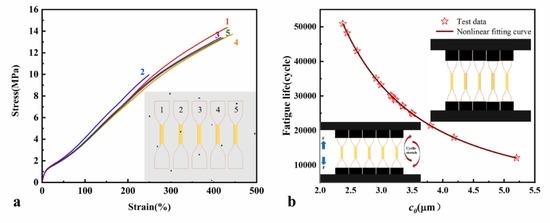Characterization and Quantitative Analysis of Crack Precursor Size for Rubber Composites
Abstract
1. Introduction
2. Experimental
2.1. Materials
2.2. Materials Preparation
2.3. Characterization
2.3.1. Nicked Angle Tear Test
2.3.2. Planar Tear Test
2.3.3. Trouser Tear Test
2.3.4. Simple Tension Test
2.3.5. Crack Propagation Test
2.3.6. Fatigue Life Test
2.3.7. Scanning Electron Microscope
3. Results and Discussion
3.1. Method 1: Critical Tear Energy Method
3.1.1. Theoretical Basis
3.1.2. Tear Energy Test
Nicked Angle Tear
Planar Tear
Trouser Tear
3.1.3. Simple Tension Test
3.1.4. Analysis of Crack Precursor Size
3.2. Method 2: Crack Propagation Method
3.2.1. Theoretical Basis
3.2.2. Crack Growth Rate Test
3.2.3. Analysis of Crack Precursor Size
3.3. Method 3: Direct Observation Method by SEM
4. Conclusions
Author Contributions
Funding
Acknowledgments
Conflicts of Interest
References
- Medina, N.F.; Garcia, R.; Hajirasouliha, I.; Pilakoutas, K.; Guadagnini, M.; Raffoul, S. Composites with recycled rubber aggregates: Properties and opportunities in construction. Constr. Build. Mater. 2018, 188, 884–897. [Google Scholar] [CrossRef]
- Wang, X.; Xia, J.; Nanayakkara, O.; Li, Y. Properties of high-performance cementitious composites containing recycled rubber crumb. Constr. Build. Mater. 2017, 156, 1127–1136. [Google Scholar] [CrossRef]
- Schleiter, K.E. Silicone breast implant litigation. Virtual Mentor 2010, 12, 389–394. [Google Scholar]
- Moon, S.-I.; Cho, I.-J.; Woo, C.-S.; Kim, W.-D. Study on determination of durability analysis process and fatigue damage parameter for rubber component. J. Mech. Sci. Technol. 2011, 25, 1159. [Google Scholar] [CrossRef]
- Young, D.G. Application of fatigue methods based on fracture mechanics for tire compound development. Rubber Chem. Technol. 1990, 63, 567–581. [Google Scholar] [CrossRef]
- Gent, A.N. (Ed.) Engineering with Rubber: How to Design Rubber Components, 3rd ed.; Hanser Publications: Cincinnati, OH, USA, 2012. [Google Scholar]
- Braden, M.; Gent, A.N. The attack of ozone on stretched rubber vulcanizates. III. Action of antiozonants. J. Appl. Polym. Sci. 1962, 6, 449–455. [Google Scholar] [CrossRef]
- Mars, W.V.; Fatemi, A. Fatigue crack nucleation and growth in filled natural rubber. Fatigue Fract. Eng. Mater. Struct. 2003, 26, 779–789. [Google Scholar] [CrossRef]
- Zine, A.; Benseddiq, N.; Abdelaziz, M.N. Rubber fatigue life under multiaxial loading: Numerical and experimental investigations. Int. J. Fatigue 2011, 33, 1360–1368. [Google Scholar] [CrossRef]
- Cadwell, S.M.; Merrill, R.A.; Sloman, C.M.; Yost, F.L. Dynamic fatigue life of rubber. Ind. Eng. Chem. 1940, 12, 19–23. [Google Scholar]
- Mars, W.V.; Fatemi, A. Multiaxial fatigue of rubber: Part II: Experimental observations and life predictions. Fatigue Fract. Eng. Mater. Struct. 2005, 28, 523–538. [Google Scholar] [CrossRef]
- Abraham, F.; Alshuth, T.; Jerrams, S. The effect of minimum stress and stress amplitude on the fatigue life of non strain crystallising elastomers. Mater. Des. 2005, 26, 239–245. [Google Scholar] [CrossRef]
- Saintier, N.; Cailletaud, G.; Piques, R. Multiaxial fatigue life prediction for a natural rubber. Int. J. Fatigue 2006, 28, 530–539. [Google Scholar] [CrossRef]
- Greensmith, H.W.; Thomas, A.G. Rupture of rubber. III. Determination of tear properties. J. Polym. Sci. 1955, 18, 189–200. [Google Scholar] [CrossRef]
- Thomas, A.G. Rupture of rubber. II. The strain concentration at an incision. J. Polym. Sci. 1955, 18, 177–188. [Google Scholar] [CrossRef]
- Lake, G.J.; Lindley, P.B. The mechanical fatigue limit for rubber. J. Appl. Polym. Sci. 1965, 4, 1233–1251. [Google Scholar] [CrossRef]
- Greensmith, H.W. Rupture of rubber. X. The change in stored energy on making a small cut in a test piece held in simple extension. J. Appl. Polym. Sci. 1963, 7, 993–1002. [Google Scholar] [CrossRef]
- Mars, W.V.; Fatemi, A. A literature survey on fatigue analysis approaches for rubber. Int. J. Fatigue 2002, 24, 949–961. [Google Scholar] [CrossRef]
- Previati, G.; Kaliske, M. Crack propagation in pneumatic tires: Continuum mechanics and fracture mechanics approaches. Int. J. Fatigue 2012, 37, 69–78. [Google Scholar] [CrossRef]
- Cha, D.W.; Jeong, H.Y. Development of a Mode III fatigue test method and a peel test method for tire specimens. Int. J. Fatigue 2011, 33, 912–920. [Google Scholar] [CrossRef]
- Zhu, C.S.; Wang, G.L.; Li, P.P.; Chen, S.W. Crack-propagating direction of tire bead rubber determined by Jmax Criterion. Appl. Mech. Mater. 2011, 43, 628–632. [Google Scholar] [CrossRef]
- Li, F.; Liu, J.; Mars, W.V.; Chan, T.W.; Lu, Y.; Yang, H.; Zhang, L. Crack precursor size for natural rubber inferred from relaxing and non-relaxing fatigue experiments. Int. J. Fatigue 2015, 80, 50–57. [Google Scholar] [CrossRef]
- Le Cam, J.B.; Huneau, B.; Verron, E.; Gornet, L. Mechanism of fatigue crack growth in carbon black filled natural rubber. Macromolecules 2004, 37, 5011–5017. [Google Scholar] [CrossRef]
- Jle Cam, B.; Huneau, B.; Verron, E. Description of fatigue damage in carbon black filled natural rubber. Fatigue Fract. Eng. Mater. 2010, 31, 1031–1038. [Google Scholar] [CrossRef]
- Cao, L.; Sinha, T.K.; Tao, L.; Li, H.; Zong, C.; Kim, J.K. Synergistic reinforcement of silanized silica-graphene oxide hybrid in natural rubber for tire-tread fabrication: A latex based facile approach. Compos. Part B Eng. 2019, 161, 667–676. [Google Scholar] [CrossRef]
- Mujtaba, A.; Keller, M.; Ilisch, S.; Radusch, H.J.; Thurn-Albrecht, T.; Saalwächter, K.; Beiner, M. Mechanical properties and cross-link density of styrene–butadiene model composites containing fillers with bimodal particle size distribution. Macromolecules 2012, 45, 6504–6515. [Google Scholar] [CrossRef]
- Yun, L.T.; Mei, S.L.; Andriyana, A. Recent advances on fatigue of rubber after the literature survey by Mars and Fatemi in 2002 and 2004. Int. J. Fatigue 2018, 110, 115–129. [Google Scholar]
- Zhang, S.; Zheng, L.; Liu, D.; Xu, Z.; Zhang, L.; Liu, L.; Wen, S. Improved mechanical and fatigue properties of graphene oxide/silica/SBR composites. RSC Adv. 2017, 7, 40813–40818. [Google Scholar] [CrossRef]
- Zine, A.; Benseddiq, N.; Abdelaziz, M.N.; Hocine, N.A.; Bouami, D. Prediction of rubber fatigue life under multiaxial loading. Fatigue Fract. Eng. Mater. 2010, 29, 267–278. [Google Scholar] [CrossRef]
- Shangguan, W.B.; Wang, X.L.; Deng, J.X.; Rakheja, S.; Pan, X.Y.; Yu, B. Experiment and modeling of uniaxial tension fatigue performances for filled natural rubbers. Mater. Des. 2014, 58, 65–73. [Google Scholar] [CrossRef]
- Thomas, A.G. Rupture of Rubber. V. Cut Growth in Natural Rubber Vulcanizates. J. Polym. Sci. Polym. Chem. 2010, 31, 467–480. [Google Scholar]
- Mars, W.V. Cracking energy density as a predictor of fatigue life under multiaxial conditions. Rubber Chem. Technol. 2002, 75, 1–17. [Google Scholar] [CrossRef]
- Weng, G.; Yao, H.; Chang, A.; Fu, K.; Liu, Y.; Chen, Z. Crack growth mechanism of natural rubber under fatigue loading studied by a real-time crack tip morphology monitoring method. RSC Adv. 2014, 4, 43942–43950. [Google Scholar] [CrossRef]
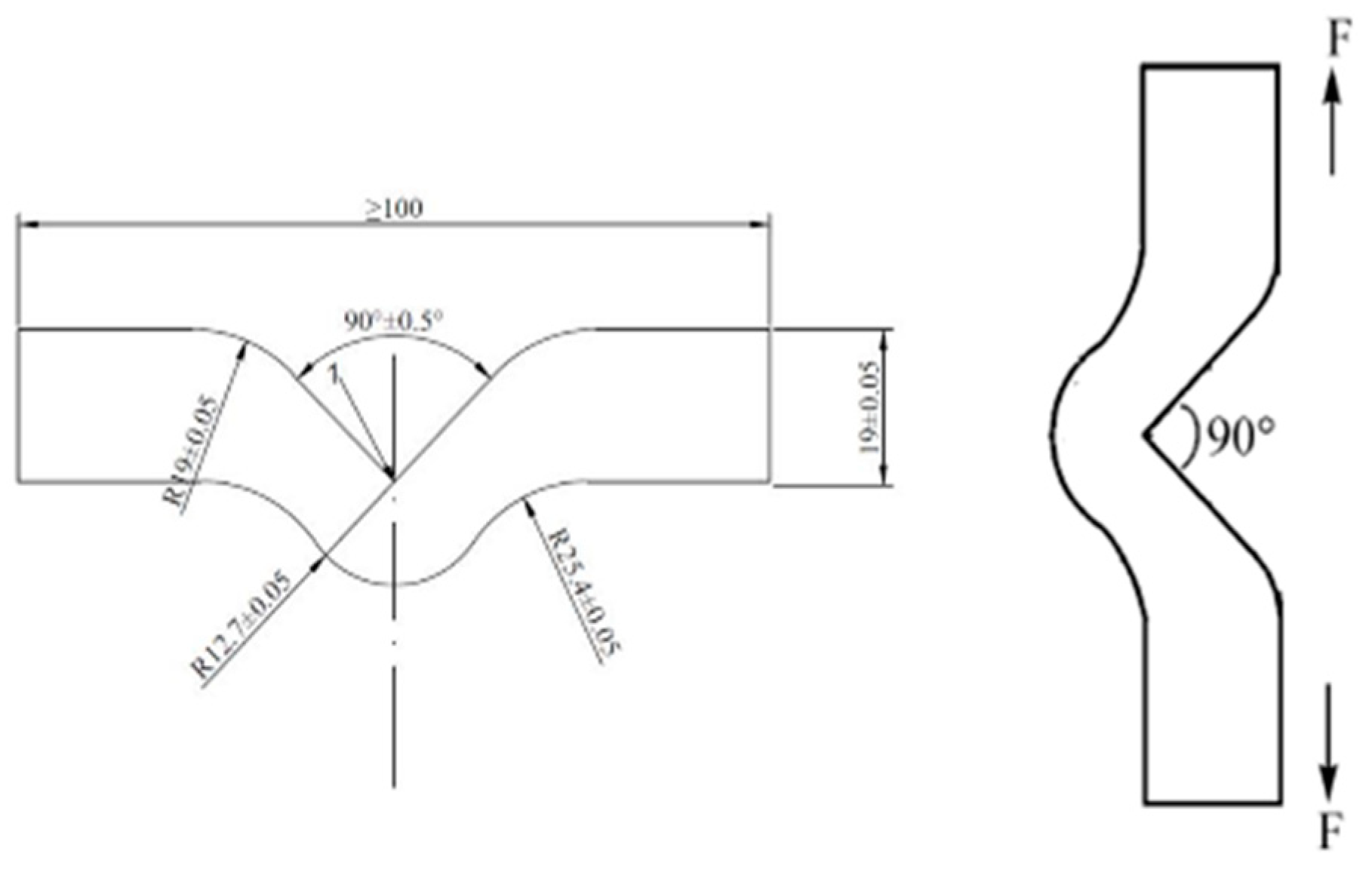


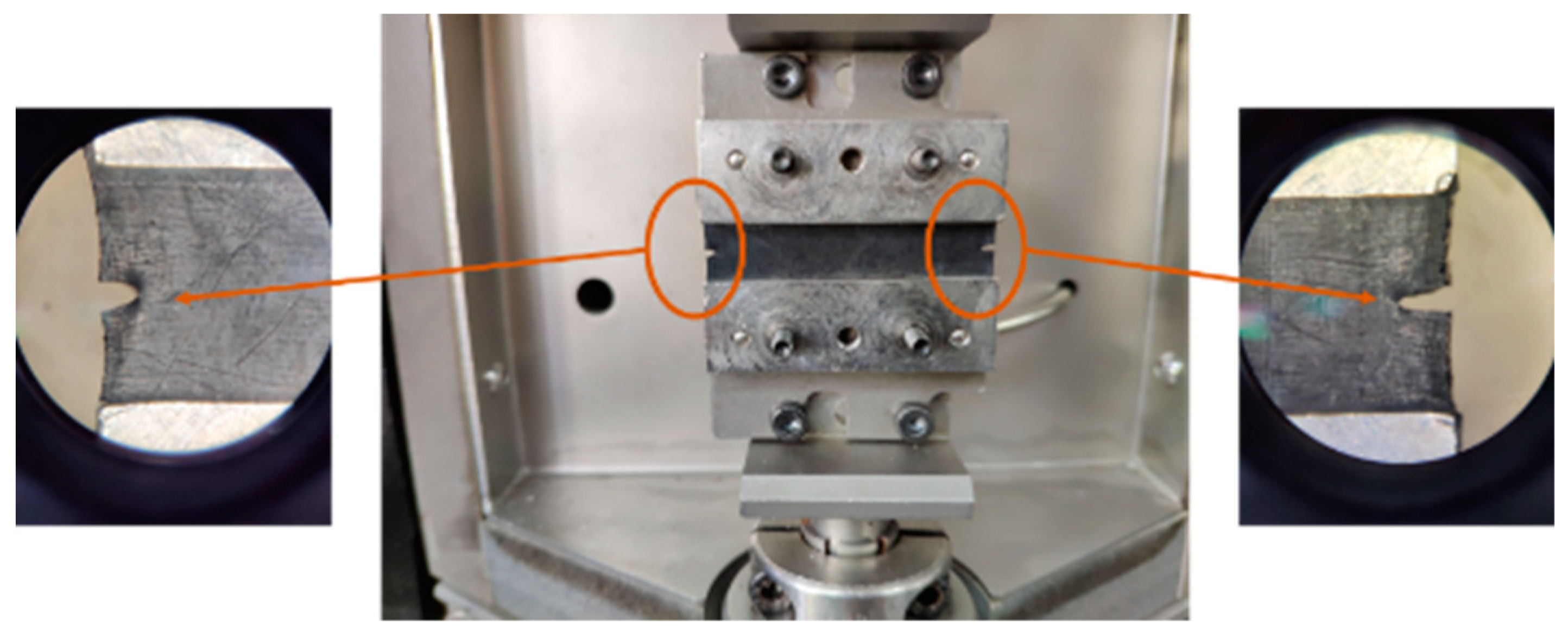

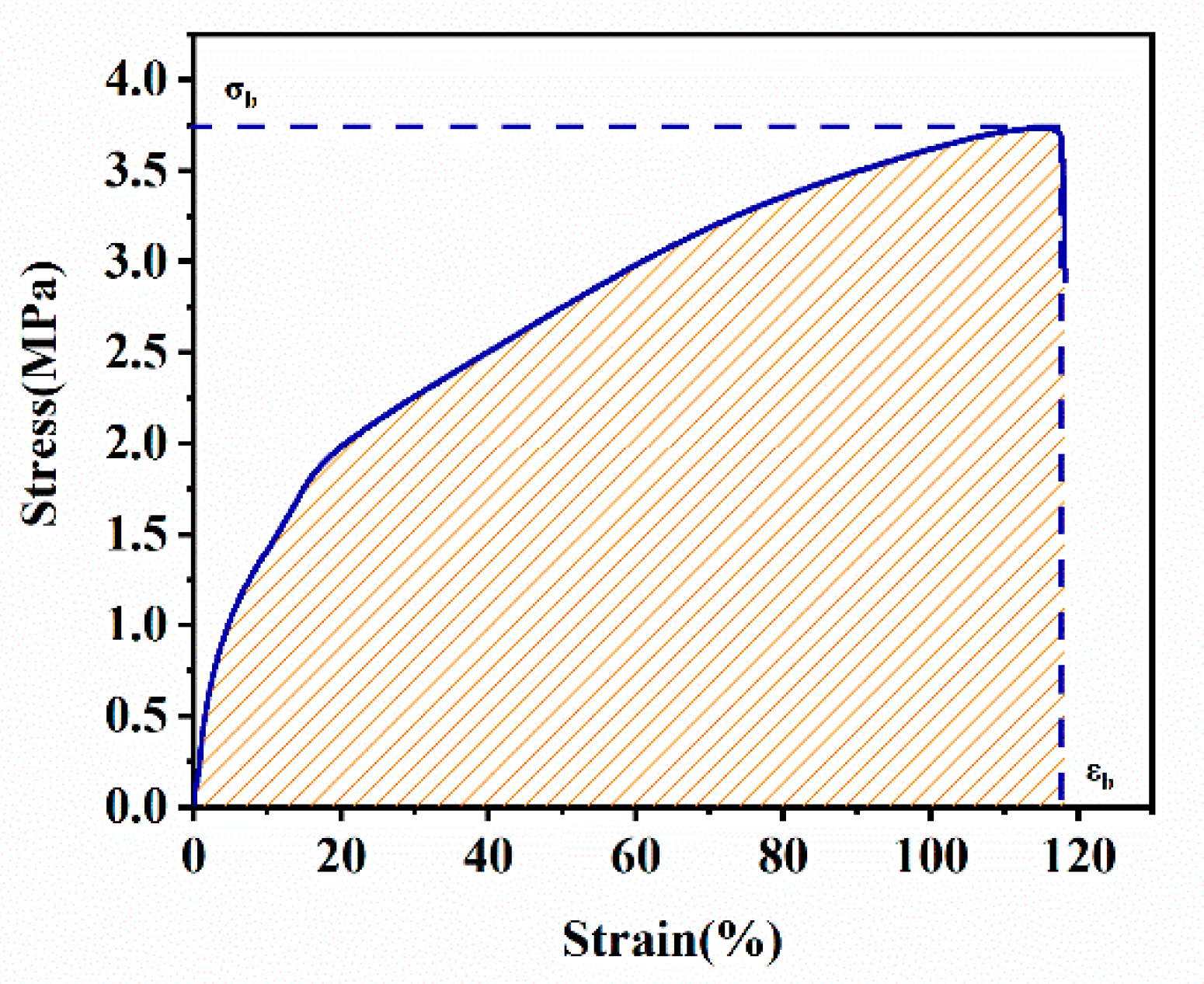

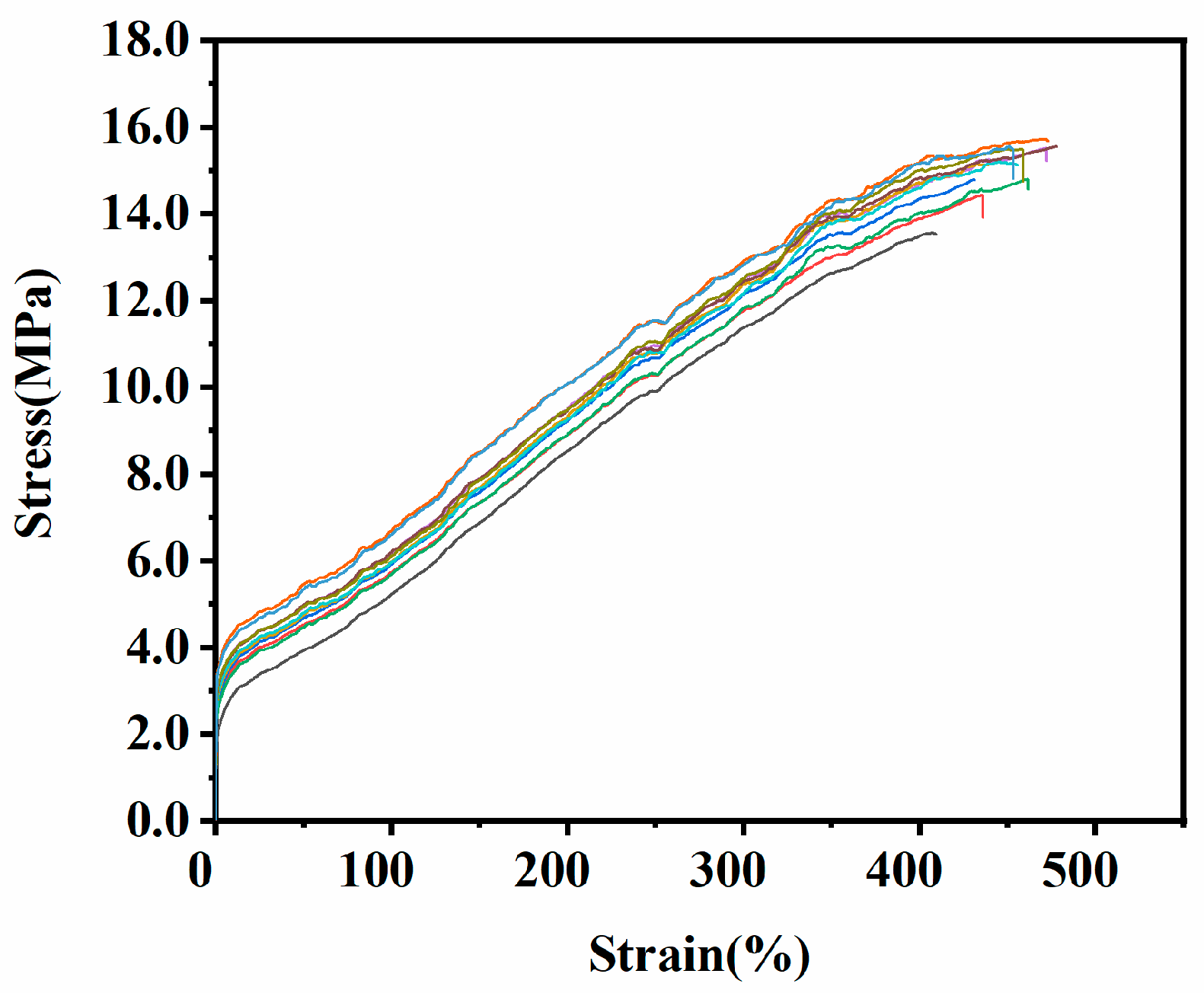
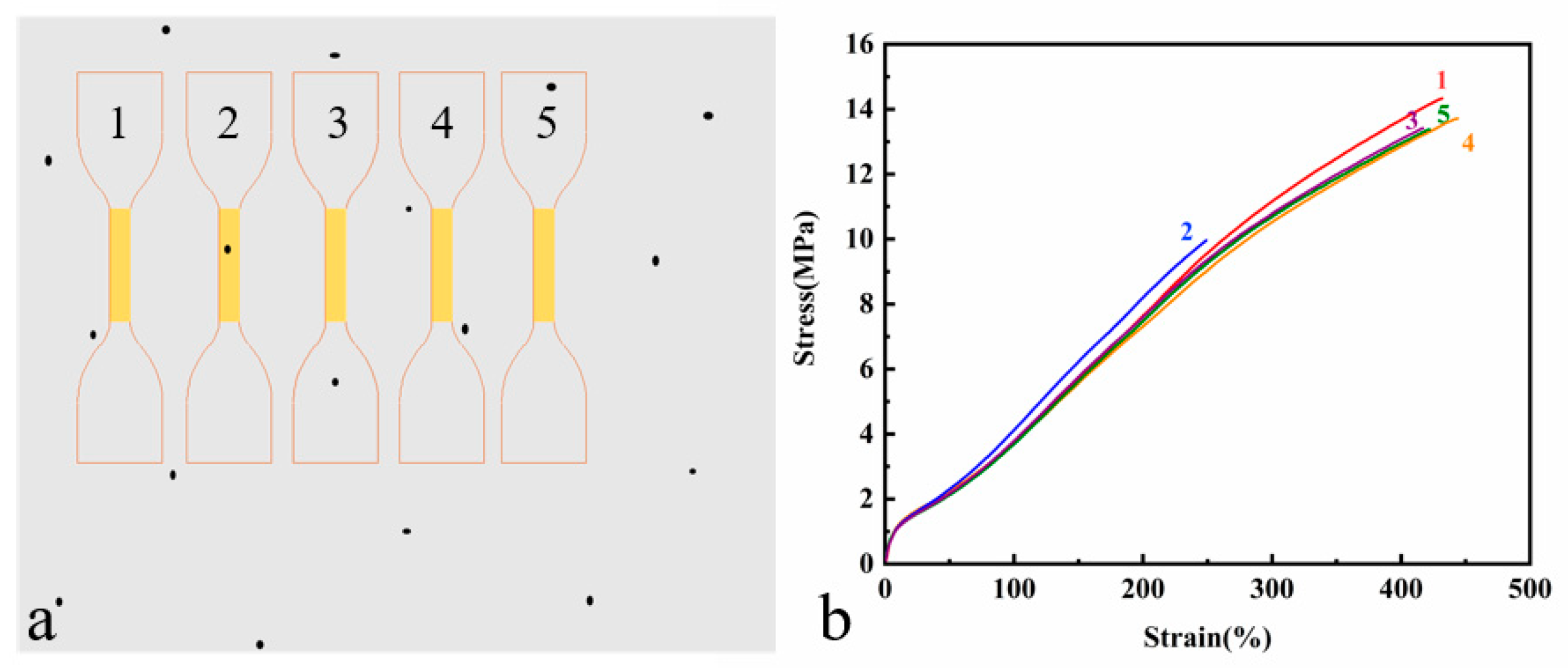


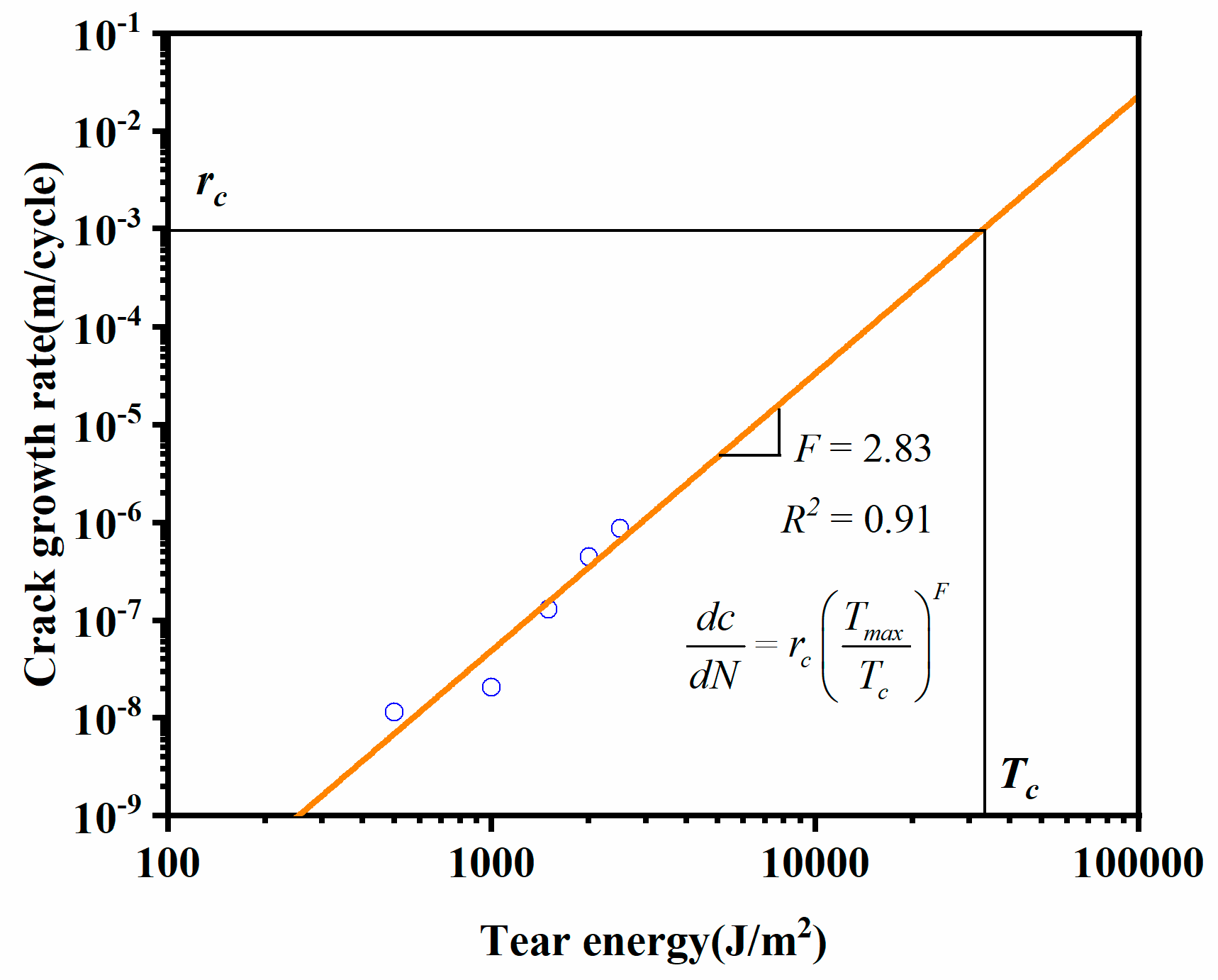
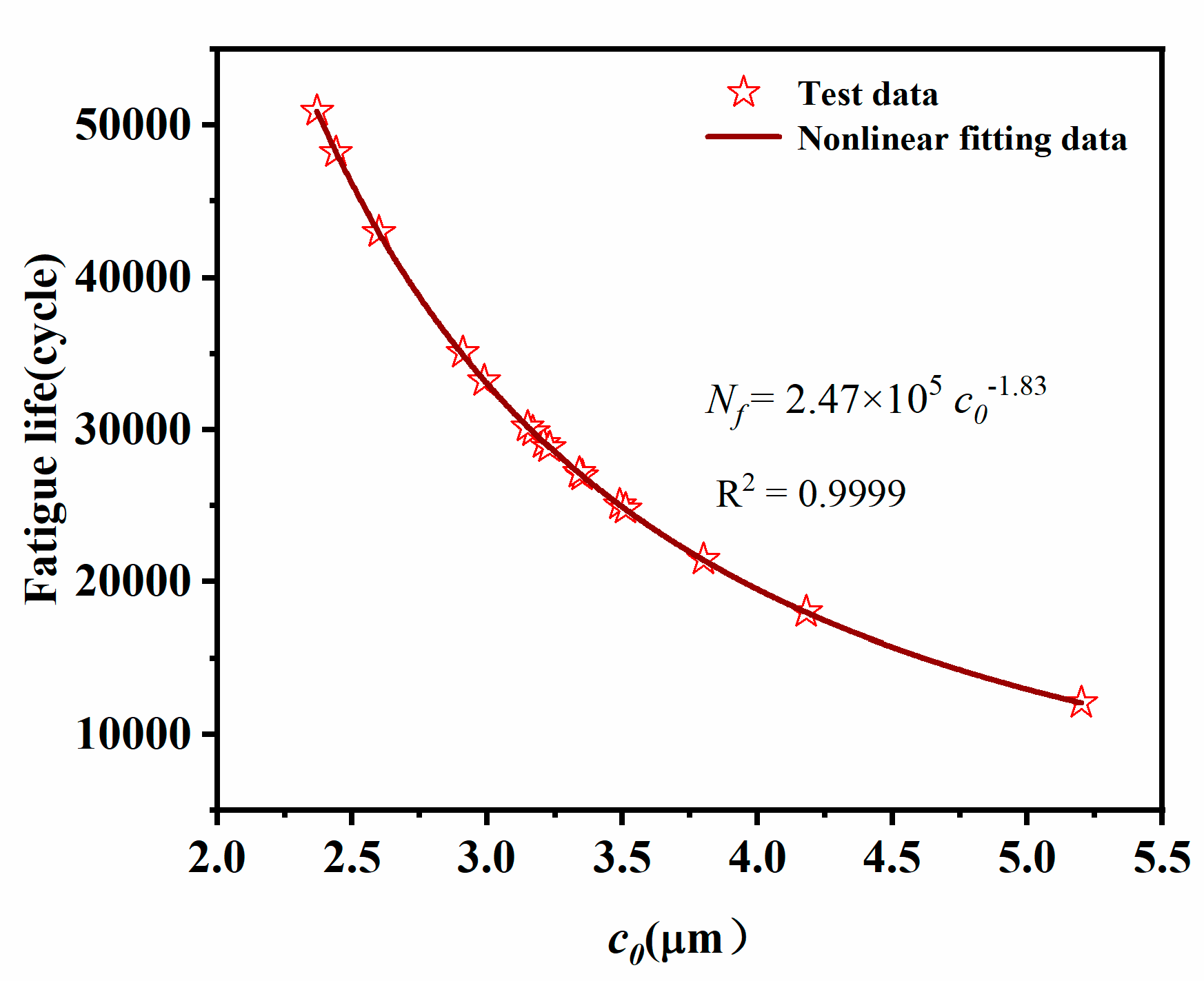

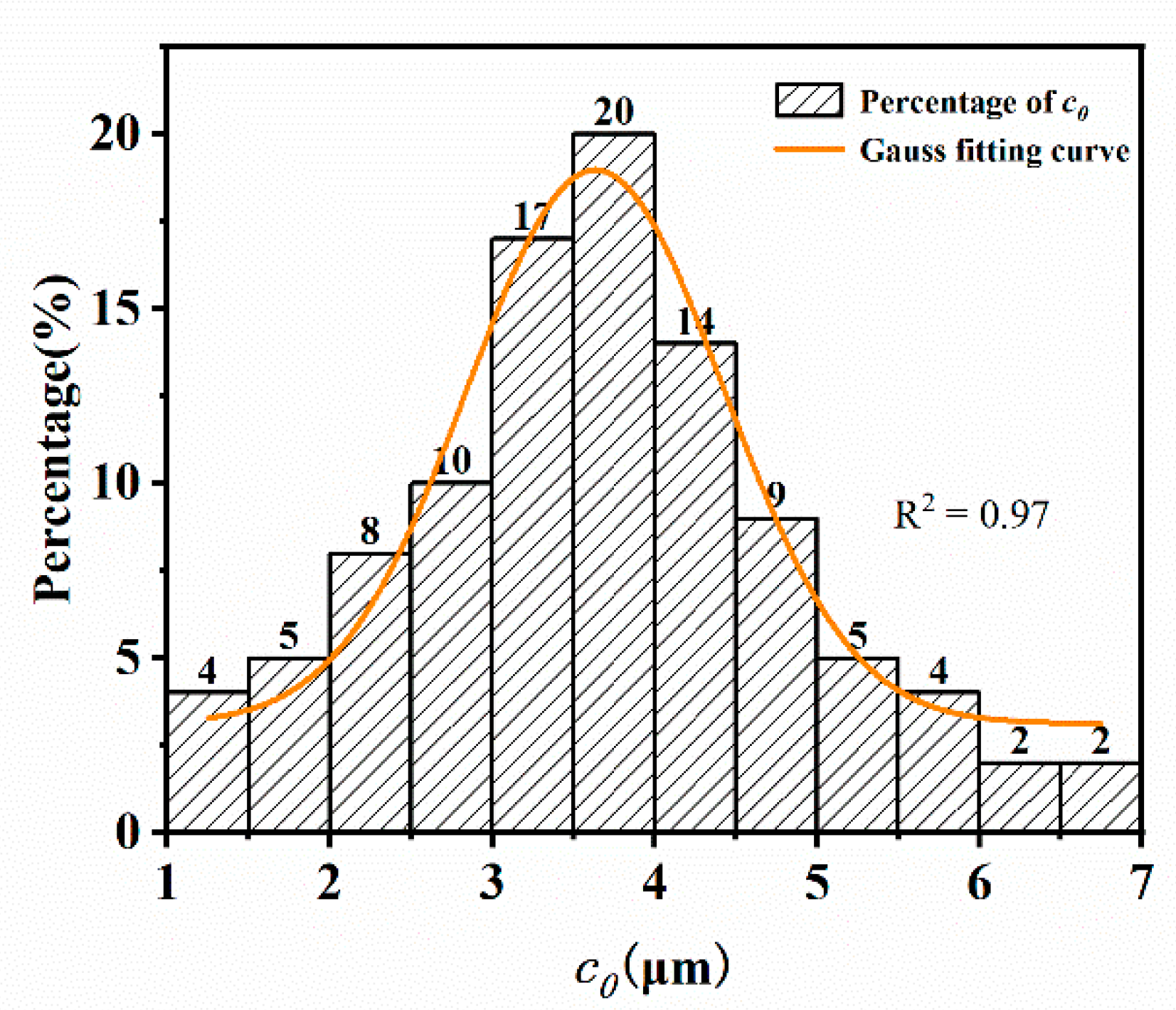
| Samples | Tensile Strength at Failure /MPa | Elongation at Break/% | Stress at 100%/MPa | Stress at 300%/MPa |
|---|---|---|---|---|
| 1# | 13.1 | 370 | 4.1 | 11.4 |
| 2# | 14.3 | 432 | 3.7 | 11.2 |
| 3# | 13.4 | 417 | 3.7 | 10.7 |
| 4# | 13.4 | 422 | 3.8 | 10.8 |
| 5# | 13.7 | 444 | 3.7 | 10.5 |
| 6# | 13.5 | 409 | 5.2 | 11.4 |
| 7# | 13.9 | 436 | 5.7 | 11.8 |
| 8# | 14.8 | 431 | 5.9 | 12.2 |
| 9# | 14.6 | 462 | 5.7 | 11.8 |
| 10# | 15.2 | 472 | 6.2 | 12.5 |
| 11# | 15.1 | 439 | 6.0 | 12.4 |
| 12# | 15.1 | 456 | 6.0 | 12.2 |
| 13# | 15.6 | 478 | 6.2 | 12.5 |
| 14# | 14.8 | 459 | 6.1 | 12.5 |
| 15# | 15.7 | 473 | 6.7 | 12.9 |
| 16# | 14.8 | 453 | 6.6 | 12.8 |
| Sample | c0 (Nicked Angle Tear) | c0 (Planar Tension) | c0 (Trouser Tear) |
|---|---|---|---|
| 1# | 608.8 | 467.7 | 222.2 |
| 2# | 505.2 | 388.1 | 184.4 |
| 3# | 551.9 | 423.9 | 201.4 |
| 4# | 549.2 | 421.9 | 200.5 |
| 5# | 520.1 | 399.6 | 189.8 |
| 6# | 552.7 | 424.6 | 201.7 |
| 7# | 517.6 | 397.6 | 189.9 |
| 8# | 490.5 | 376. 8 | 179.0 |
| 9# | 477.9 | 367.2 | 174.4 |
| 10# | 451.4 | 346.8 | 164.8 |
| 11# | 474.2 | 364.3 | 173.1 |
| 12# | 464.1 | 356.5 | 169.4 |
| 13# | 438.9 | 337.2 | 160.2 |
| 14# | 473.8 | 363.9 | 172.9 |
| 15# | 437.9 | 336.4 | 159.8 |
| 16# | 475.1 | 365.0 | 173.4 |
| average | 499.3 | 383.6 | 182.3 |
| Tear Energy (J/m2) | Crack Growth Rate (m/cycle) |
|---|---|
| 500 | 1.15 × 10−8 |
| 1000 | 2.06 × 10−8 |
| 1500 | 1.30 × 10−7 |
| 2000 | 4.47 × 10−7 |
| 2500 | 8.72 × 10−7 |
| Sample | Nf | c0 (μm) |
|---|---|---|
| 1# | 26,978 | 3.4 |
| 2# | 29,098 | 3.2 |
| 3# | 27,179 | 3.3 |
| 4# | 50,921 | 2.4 |
| 5# | 21,472 | 3.8 |
| 6# | 48,201 | 2.4 |
| 7# | 29,881 | 3.2 |
| 8# | 30,198 | 3.2 |
| 9# | 35,084 | 2.9 |
| 10# | 25,064 | 3.5 |
| 11# | 24,792 | 3.5 |
| 12# | 12,094 | 5.2 |
| 13# | 18,025 | 4.2 |
| 14# | 33,219 | 3.0 |
| 15# | 28,843 | 3.2 |
| 16# | 43,005 | 2.6 |
© 2019 by the authors. Licensee MDPI, Basel, Switzerland. This article is an open access article distributed under the terms and conditions of the Creative Commons Attribution (CC BY) license (http://creativecommons.org/licenses/by/4.0/).
Share and Cite
Guo, H.; Li, F.; Wen, S.; Yang, H.; Zhang, L. Characterization and Quantitative Analysis of Crack Precursor Size for Rubber Composites. Materials 2019, 12, 3442. https://doi.org/10.3390/ma12203442
Guo H, Li F, Wen S, Yang H, Zhang L. Characterization and Quantitative Analysis of Crack Precursor Size for Rubber Composites. Materials. 2019; 12(20):3442. https://doi.org/10.3390/ma12203442
Chicago/Turabian StyleGuo, Hao, Fanzhu Li, Shipeng Wen, Haibo Yang, and Liqun Zhang. 2019. "Characterization and Quantitative Analysis of Crack Precursor Size for Rubber Composites" Materials 12, no. 20: 3442. https://doi.org/10.3390/ma12203442
APA StyleGuo, H., Li, F., Wen, S., Yang, H., & Zhang, L. (2019). Characterization and Quantitative Analysis of Crack Precursor Size for Rubber Composites. Materials, 12(20), 3442. https://doi.org/10.3390/ma12203442




